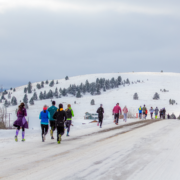By: Andrew Traver, PT, DPT
With summer running events looming, some runners may be initiating the early stages of their offseason training programs. Proper preparation is key for those who are expecting to participate in a running event(s), both for elevating personal performance and reducing the risk of injury along the way. While training programs can be well-intentioned, sometimes there are factors beyond our control that can impact the implementation of these plans and leave us feeling like we are missing opportunities to prepare. For instance, those prepping in the wintertime may find themselves sidelined due to hazardous street and trail conditions. Strapping on the spikes may be an answer for some, but there may be a safe and effective alternative to braving the icy, snowy terrain.
What is Cross Training?
Cross training is the performance of an exercise or activity that is outside of one’s primary sport. This can be a valuable training tool for recreational athletes to incorporate into their exercise routine(1). For runners, reasons for cross training can include increasing strength, maintaining or increasing cardiovascular endurance, and/or decreasing the risk for overuse injuries(2,3). Another benefit of cross training is that it can decrease the amount of mental fatigue that can come with repeating the same activity. Also, using cross training activities can provide a much-needed alternative when circumstances outside our control hit, like an icy storm that can come during the Montana winters.
How do I Cross Train?
The opportunities for cross training can came in various forms. Here are a couple of options for cross training that are some local favorites:
Cross-Country Skiing
Cross-country skiing is a great way to supplement a running program during the winter season while enjoying the outdoors and keeping focused on cardiovascular endurance. Cross-country skiing also gives the additional benefit of incorporating the upper extremities, creating a total body workout(4). Locally, some places to cross-country ski include the University golf course, Lolo Pass, and Lubrecht Experimental Forest.
Cycling
Cycling is another option that allows for low-impact training while remaining focused on lower extremity muscles. These muscles include the quads and glutes which are important for runners to develop and strengthen(5). The use of traction technology for bike tires allows riders to remain outdoors during the wintertime, but indoor cycling on a spin bike or recumbent bike can also do the trick.
Strength Training
Tried and true, good old fashion resistance training can provide a much-needed boost to your running routine. Focusing on running specific muscles(quads, hamstring, calves, and glutes), resistance training can be adjusted to fit your training needs. From high-intensity interval training to heavy, slow resistance training, there is a routine that works for you which will complement your running goals and keeps you on track.
Side note: including plyometrics, such as jumping rope, into your training regimen can boost your running performance!(6)
Rowing:
Incorporating both the upper and lower body, a rowing machine allows individuals to utilize similar training principles that they use for running, such as intervals and intensity. Most gyms have rowing machines available but be sure to ask for assistance from a trainer regarding setup and performance if it is your first time.
Swimming:
The ultimate off-loading activity, swimming provides individuals a way to bring together a total body exercise in a low-stress environment(7). In Missoula, Currents aquatic center, the Peak, the University of Montana, and the YMCA are all places where you can wet your exercise whistle.
Conclusion
Cross training can be a valuable addition to a running program regardless of winter weather. Although, on those cold, dark winter mornings and evenings, supplementing a cross training workout can be a welcomed alterative. If you have any questions or concerns about your ability to perform some of these suggested activities, contact your local physical therapist or doctor for assistance.
References:
1.Loy, S. F., Hoffmann, J. J., & Holland, G. J. (2012, October 7). Benefits and practical use of cross-training in sports – sports medicine.https://link.springer.com/article/10.2165/00007256199519010-00001
2.Lauersen JB, Bertelsen DM, Andersen LB The effectiveness of exercise interventions to prevent sports injuries: a systematic review and meta-analysis of randomised controlled trials British Journal of Sports Medicine 2014;48:871-877.
3.Brushøj C, Larsen K, Albrecht-Beste E, Nielsen MB, Løye F, Hölmich P. Prevention of overuse injuries by a concurrent exercise program in subjects exposed to an increase in training load: a randomized con- trolled trial of 1020 army recruits. Am J Sports Med. 2008;36:663- 670. https://doi.org/10.1177/0363546508315469
4.Sandbakk, Ø., Hegge, A. M., Losnegard, T., Skattebo, Ø., Tønnessen, E., & Holmberg, H.-C. (2016, June). The physiological capacity of the world's highest ranked female cross-country skiers. Medicine and science in sports and exercise. Retrieved January 18, 2023, from https://www.ncbi.nlm.nih.gov/pmc/articles/PMC5642331/





